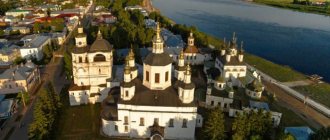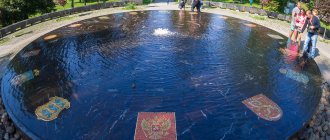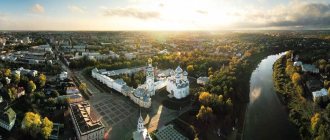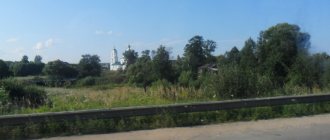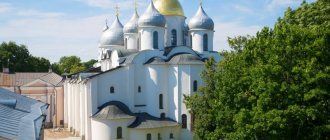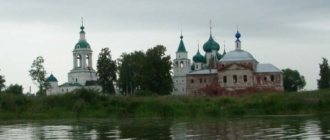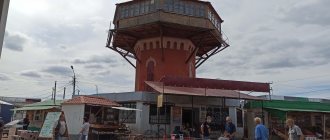Founded: 1147
Veliky Ustyug - the soul of the Russian North
Veliky Ustyug
- a Russian city located in the Vologda region, on the left bank of the Sukhona River at the confluence of the Yug River.
First
the settlement was mentioned under the name Gleden in 1147. In 1212, the Mikhailo-Arkhangelsky Monastery was built at the mouth of the Yug River, which is why the place is called Ustyug.
In 1218, Ustyug was ravaged by the Kama Bulgarians. In the 14th century, a struggle took place between the Novgorod and Moscow principalities for possession of the city, which controlled the waterway along the northern rivers. In 1398, the Assumption Cathedral was plundered and burned by the Novgorodians, and the icon of the Miraculous Hodegetria was taken prisoner.
In 1399, Bishop John of Novgorod ordered the miraculous icon to be returned and the Ustyug Cathedral to be rebuilt. At the end of the 14th century, Ustyug finally became part of the Moscow Principality and became the center of the annexation of the northern lands.
In 1465, the Ustyuans conquered the Ugra land, in 1472 they helped annex the Perm land, and in 1489, the Vyatichi land. In the mid-16th century, Ustyug ceased to be a border fortification and lost its military significance.
In 1553, a trade route to the West was opened - from Vologda through the Sukhona and Northern Dvina to the White Sea. Ustyug occupied an important position on this path. In 1565, Ivan the Terrible included Ustyug among the oprichnina cities that provided money for the sovereign's household needs. During this period, the epithet Great was added to the name of the city.
In the 18th century, the Northern trade route lost its importance. Urban trade is declining, and handicraft industries and crafts are developing in the city. In 1918 – 1929 Veliky Ustyug was the center of the North Dvina province of the RSFSR. Nowadays the city is widely known as a tourist center.
There are 28 churches in the city (17-18th century): the Assumption Cathedral, the Cathedral of Procopius the Righteous, the Cathedral of John of Ustyug, the Church of Sergius of Radonezh and others. Several dozen monuments of urban architecture of the 19th century.
Tower of Father Frost
It is interesting
that in 1999 Veliky Ustyug was declared the birthplace of the Russian Father Frost. In addition to Father Frost, the city is famous for other famous travelers: Semyon Dezhnev, who discovered the strait between Asia and America. Erofei Khabarov, who paved the way to the banks of the Amur and compiled its first map. Vasily Shilov and Mikhail Navodchikov are the discoverers of the Aleutian Islands. Vladimir Atlasov, who explored Kamchatka.
The city has a population of about 31 thousand people (2020).
Day of the city
was celebrated in mid-June and was famous for the fact that only in Veliky Ustyug on City Day did Father Frost congratulate the townspeople. However, recently the local administration decided to combine City Day and the Prokopyevskaya Fair, which is dedicated to the day of memory of Procopius the Righteous, the heavenly patron of Ustyug, whose memory is celebrated on July 21.
Veliky Ustyug
Veliky Ustyug
– administrative center of the Veliky Ustyug region. City of regional subordination. It is located 450 km northeast of Vologda on the left bank of the Sukhona River. The population of the city as of January 1, 2014 was 31,983 people. The founding date of the city is considered to be 1147.
The first settlement in the area of present Veliky Ustyug - Gleden
- was founded by the Grand Duke of Vladimir Vsevolod the Big Nest on a high mountain at the confluence of the Sukhona with the South, four kilometers from the modern city
in the 12th century
. According to legend, the name Gleden is associated with the fact that this mountain offered a good view of the surrounding area. Due to the changing flow, the Sukhona River began to wash away the right bank, on which Gleden was located. In view of this, already in the 12th century, the townspeople began to move to the left bank of the Sukhona and founded a new settlement there, named after the mouth of the Yug River - Ust-Yug or Ustyug.
For several centuries, Ustyug and Gleden existed in parallel
. In the first half of the 15th century, Gleden took part in the feudal wars between the Moscow and Zvenigorod princes. In 1436, after a two-month siege, the city was taken by Vasily Kosy, and in 1438 it was completely destroyed by the Vyatichi. After this, the city was never restored. Some of the residents went to Veliky Ustyug, some to the village of Morozovitsa, known since 1440. The Trinity-Gledensky Monastery, founded in the 12th century, remains in memory of the city.
The first reliable information about Ustyug dates back to 1212 .
, when the Archangel Michael Monastery was founded in the settlement. From its very foundation, Ustyug served as a stronghold for the Rostov-Suzdal princes, blocking the way for the Novgorodians to ancient Zavolochye. In the XIV-XV centuries, the struggle that flared up for the North did not leave Ustyug aside. The Novgorodians attacked him six times. The residents of Ustyug sided with the Moscow princes. At the end of the 14th century, under Grand Duke Vasily I, Ustyug finally became part of the Moscow Principality.
In the second half of the 15th century, Ustyug played a major role in the gathering of northern lands under the rule of Moscow
. The Ustyug regiments made more than a dozen military campaigns. In 1465, “willing people” from Ustyug went to fight in the Ugra land and, having captured the local princes, imposed tribute. In 1471, a campaign was launched against the Dvina colonies of Novgorod, which ended in a victorious battle on the Shilenga River. In 1472, not without the participation of the Ustyug people, the Perm land was annexed to the Moscow state, and in 1489 - the land of the Vyatichi.
In the middle of the 16th century, Ustyug ceased to be a marginal fortification and lost its military significance. However, due to its favorable geographical position and in connection with the opening of the trade route along the Sukhona and Northern Dvina to the White Sea, it continued to develop as a trading center
. Ustyug became the country's main fur market. The growth of trade gave impetus to the development of handicrafts and arts and crafts. In the 16th century, the commercial importance of Ustyug increased so much that Ivan IV included it among the oprichnina cities that provided money “for the sovereign’s use.” It was during this period that the name “Great” was established for him. In the 16th-18th centuries, wealthy Ustyug merchants erected and decorated numerous churches and built stone houses. At the beginning of the 20th century in Veliky Ustyug, services were held in 27 churches and 4 monasteries. Many of them have survived to this day.
Cathedral courtyard
- the main temple ensemble of Veliky Ustyug - includes the Assumption Cathedral of 1652-1663 with a bell tower, the Cathedral of Procopius the Righteous of 1668, the Cathedral of John of Ustyug of the 17th-19th centuries, the Bishop's House of the 18th century, as well as several more churches and a number of outbuildings.
Michael the Archangel Monastery
- the second most important architectural ensemble of the city, the main stone buildings of which were built in the second half of the 17th century.
Church of the Ascension
at the Market in 1648 - the earliest surviving monument of Ustyug stone architecture. This is one of the most impressive temples in Veliky Ustyug.
Dymkovskaya Sloboda
- a church ensemble of the 18th century, located on the other side of the Sukhona from the Cathedral Courtyard.
Veliky Ustyug is the birthplace of outstanding sailors and explorers
.
Enterprising Ustyug residents, before others, walked the length and breadth of Siberia from the Urals to the Pacific Ocean, which was the impetus for the beginning of geographical discoveries of Russian explorers in Eastern Siberia and beyond. These discoveries began in 1648 with the campaign of Semyon Ivanovich Dezhnev
, a resident of Ustyug. Having set off on a journey on small ships - “kochs”, Dezhnev was the first in the world to prove the existence of a strait between Asia and America, described Chukotka in detail, founded the Anadyr fortress and returned to Moscow. The Strait later became known as the Bering Strait, but it was Dezhnev who discovered it 80 years before Bering. Historical justice has been partially restored - the easternmost point of Asia is now named after Dezhnev.
In 1649, another Ustyug resident Erofey Pavlovich Khabarov
established the shortest route from Yakutsk to the Amur, sailed along the latter all the way to the sea, compiled a description of the lands he saw and a “drawing of the Amur River.” The city of Khabarovsk is named after him.
In 1697 Vladimir Atlasov
discovered and described Kamchatka and the Kuril Islands, thereby marking the beginning of a period of intensive exploration of the coasts and islands of the Pacific Ocean.
In 1745, Mikhail Nevodchikov
explored the Aleutian Islands; in 1748,
Afanasy Bakhov,
together with the Yakut merchant Novikov, saw the previously unexplored northern shores of America; in 1764, the merchant Vasily Shilov drew up a map of the Aleutian Islands and took an active part in their development. For this, he received a medal from Catherine II “for his zeal in collecting new islands for Kamchatka.” As a result of all these “collections”, the North-Eastern Company was organized in 1789, which later became known as the Russian-American Company. Ustyug merchant Mikhail Buldakov becomes one of the first directors of the company.
In the 18th century, due to the movement of trade routes, Veliky Ustyug, like many other northern cities, lost its trade and transport significance. With the loss of its former glory, the administrative position of Ustyug also changed. Until the end of the 17th century, it was the center of a vast territory. In 1682-1788, Veliky Ustyug was the center of the Veliky Ustyug and Totem diocese. In 1708, when Peter I divided the country into eight provinces, Veliky Ustyug became the center of the Veliky Ustyug district and became part of the Arkhangelsk province. Since 1719, Veliky Ustyug has been the center of the Veliky Ustyug province. Since 1780 - as part of the Vologda governorate. It entered the 19th century as a district town of the Vologda province. In 1918-1929, Veliky Ustyug was the center of the North Dvina province of the RSFSR.
In the 17th century, a famous Russian folk art craft developed in Veliky Ustyug - Veliky Ustyug blackening on silver
. In 1933, the Northern Mob artel was formed (currently producing artistic silver products, including jewelry).
In the second half of the 19th – early 20th centuries, the enterprising Ustyug merchants opened a number of industrial establishments
, whose products were widely sold. The finest linen from the best varieties of local flax was woven at the Krasavino factory of the heirs of Y. Gribanov. The Chebaevsky oil mills produced linseed oil and drying oil, I. Ya. Lvov produced plywood, and L. G. Zebalda produced excellent quality beer and lemonade. Great merit belonged to the people of Ustyug in the development of shipping on the northern rivers. A pier and Mikhailovsky ship repair and construction workshops were opened in the city. In the 1910s, Ustyug ranked second in industrial development after the provincial center.
The first museum of Veliky Ustyug - an ancient storage facility - was opened in 1910
in the building of the Vvedenskaya Church of the Archangel Michael Monastery. During its existence, antiquities from the Archangel Michael, St. John the Baptist, Trinity-Gledensky monasteries, the Assumption Cathedral, Cyril and Methodius, Spasovsegrad, Sretenskaya Myrrh-Bearing churches were transferred to the ancient repository. The most valuable funds of the ancient repository became the basis of the Museum of Severodvinsk Culture, created in 1918.
The brightest and most dramatic pages in the history of the museum are its uncompromising struggle to preserve the architectural appearance of Veliky Ustyug. In 1924, the St. Michael the Archangel Cathedral and the Vladimir Church of the St. Michael the Archangel Monastery were transferred to the jurisdiction of the Museum of Severodvinsk Culture; in 1926, the Trinity Cathedral of the Trinity-Gleden Monastery with its unique iconostasis, wooden sculpture and bells.
In the 1970s, active work began to restore the historical and cultural monuments of the city, which continues to this day.
Veliky Ustyug is one of the Russian cities with a particularly valuable historical heritage
. The existing historical appearance of the city is formed by a harmonious combination of ancient stone churches and city estates. The city has 150 cultural heritage sites of federal and regional significance.
The monuments of Veliky Ustyug are the object of constant attention of thousands of tourists who visit the city every year. The development of tourism is actively promoted by the project “Veliky Ustyug - the Homeland of Father Frost,” which has been implemented since 1998.
The following sources were used in preparing the material:
— Vologda Encyclopedia. – Vologda, 2006;
— Cities of Russia: Encyclopedia. – M., 1994;
— Our region is Vologda. – Arkhangelsk, 1982;
— Stepanovsky I.K. Vologda antiquity. Historical and archaeological collection. – Vologda, 1890;
— Encyclopedic Dictionary of Brockhaus and Efron. – St. Petersburg, 1890-1907;
— www.vologda-oblast.ru: website of the Government of the Vologda Region;
— www.v-ustug.ru: website of the city of Veliky Ustyug;
— www.severgrad.com: tourist website;
— wikipedia.org: site of the free, publicly accessible multilingual universal encyclopedia Wikipedia.
Tweet
Share
Share
Cool
Administrative and municipal status
Within the structure of administrative units, Veliky Ustyug serves as the administrative center of Veliky Ustyug District,[6] although it is not part of it.[1] As an administrative division, together with the town of Krasavino and the working settlement of Kuzino, included separately as a city of regional significance of Veliky Ustyug
- one of four administrative units in the region with a status equal to that of districts.[2]
As part of the structure of municipalities, the city of Veliky Ustyug, together with the village from Slobodka in the Yudinsky Village Council of the Veliky Ustyug District, is registered as the Urban Settlement of Veliky Ustyug
within the Veliky Ustyug Municipal District.[7] The city of Krasavino, together with six rural settlements in the city of Krasavinsky village council of the Veliky Ustyug region - the urban settlement of Krasavino, the working village of Kuzino - the urban settlement of Kuzino; both are also in the Veliky Ustyug municipal district.[7]
Transport
| Yadrikha – Veliky Ustyug | ||
| symbols | 0 | Jadriha |
The fleet consists of LiAZ-677, LiAZ-677M, LiAZ-5256, MAZ-103, MAN SL 200, Ikarus-280, Ikarus-260, Ikarus-415, LAZ 695N, PAZ 3205, operating on urban routes.
The monopolist in passenger transportation is Veliky Ustyug PATP. Private carriers operate a number of flights to the nearby suburbs. The cost of travel around the city from September 1, 2010 is 12 rubles [ clarify
].
11.4. Intercity
Veliky Ustyug has a constant bus service with Vologda, Kotlas, Cherepovets, Arkhangelsk, Severodvinsk, Kichmengsky Gorodok, Koryazhma, Nikolsk, Nyuksenitsa and Tarnoga[10].
11.5. Taxi
There are several companies providing taxi services in Veliky Ustyug. The average cost of one trip around the city in January 2011 ranged from 50 to 100 rubles. Depending on the taxi company.
11.6. River transport
There is a ferry connection to the side beyond the river. Ferry route:
- st. Vasendina - Koromyslovo - Kuzino - Aristovo
further reading
- (in Russian) Ustyug Veliky. Materials on the history of the 17th - 18th centuries (1883) (Ustyug the Great. Materials for the history of the city of the 17th and 18th centuries) on Runivers.ru in DjVu and PDF formats
- Brumfield, William S. Veliky Ustyug
(M.: Three Squares, 2007) OCLC 174531901 (in English and Russian) - Brumfield, W (no date) Veliky Ustyug: a look through the lens of an American scientist-photographer. Full text is available at www.pomorsu.ru/Brumfield/velikii_ustiug.htm
- Gardner, N. (2005) Article in Hidden Europe, 5 (November 2005), pp. 22–26. The full text is available (html and pdf versions) on the Hidden Europe website
Physiographic characteristics
2.1. Geographical position
Veliky Ustyug is located in the central part of the East European Plain on the left bank of the Sukhona River, at the source of the Northern Dvina. The average altitude above sea level is 70 m.
2.2. Climate
| Climate of Veliky Ustyug | |||||||||||||
| Index | Jan | Feb | Mar | Apr | May | Jun | Jul | Aug | Sep | Oct | But I | Dec | Year |
| Average maximum, °C | ?11 | ?8 | ?1 | 7 | 14 | 20 | 23 | 19 | 12 | 5 | ?4 | ?9 | |
| Average temperature, °C | ?12,5 | ?11 | ?5,3 | 1,8 | 9,3 | 15,7 | 18,1 | 14,3 | 8,6 | 1,8 | ?7 | ?10,9 | 2 |
| Average minimum, °C | ?16 | ?14 | ?9 | ?2 | 4 | 9 | 12 | 9 | 5 | 0 | ?8 | ?13 | |
| Precipitation rate, mm | 2,64 | 2,5 | 2,27 | 2,52 | 3,21 | 4,9 | 5,71 | 4,9 | 3,58 | 3,74 | 3,38 | 2,78 | 42,05 |
| Source: Monthly Averages for Velikiy Ustyug, RUS[ not in source | |||||||||||||
2.3. Timezone
The city of Veliky Ustyug, as well as the entire Vologda region, is located in a time zone designated by the international standard as Moscow Time Zone (MSK). The offset from UTC is +4:00.
Mass media
13.1. A television
There are 5 federal TV channels available to the public in the city:
“Channel One” “Russia-1” + State Television and Radio Broadcasting Company Vologda “Russia-Culture” “NTV” “REN-TV” + TV Channel “Province”
13.2. Newspapers
- “Soviet Thought” “Ustyuzhanochka”[11] “South of the North”[12] “Business Ustyuzhanochka”[11]
13.3. Radio
- "Radio of Russia" + (VGTRK and its regional representative - Vologda Regional Radio[13]) - 66.86 FM "Mayak" - 68.6 FM "YuFM" - 69.62 FM "Transmit" (Cherepovets)[14] - 102.3 FM “Russian Radio” + Russian Radio (Veliky Ustyug) - 103.5 FM
13.4. Cable TV
Cable TV services in the city are provided by two companies.
Social sphere
8.1. Demography
| Population | |
| Year | Population |
| 1856 | 8000 |
| 1897 | 11 300 |
| 1926 | 19 100 |
| 1931 | 23 400 |
| 1939 | 32 100 |
| 1959 | 37 000 |
| 1967 | 35 000 |
| 1970 | 36 700 |
| 1979 | 37 900 |
| 1989 | 36 200 |
| 1992 | 36 200 |
| 1996 | 35 800 |
| 1998 | 35 400 |
| 2000 | 35 000 |
| 2001 | 34 600 |
| 2003 | 33 400 |
| 2005 | 32 700 |
| 2006 | 32 400 |
| 2007 | 32 100 |
| 2008 | 32 000 |
| 2010 | 31 664 |
| Source |
According to the 2010 All-Russian Population Census, the population of Veliky Ustyug was 31,664 people[6].
According to census data:
| Population | |||||
| 1959 | 1970 | 1979 | 1989 | 2002 | 2010 |
| 37 026 | 36 737 | 37 916 | 36 202 | 33 419 | 31 664 |
8.2. Culture
There are studios (including a theater studio) at the House of Culture. In 2006, the Russian North art gallery was opened in the city.
8.3. Ecology
8.4. Health
The following medical and health institutions are located in Veliky Ustyug:
- Veliky Ustyug Central District Hospital 2 children's clinicsAdult clinic Rehabilitation clinic Health center
8.5. Education
The city has 6 schools, a gymnasium, a correctional boarding school and a school for working youth, 5 secondary specialized educational institutions, 2 branches of Vologda universities.
There are 20 institutions operating in preschool education.
Additional education is provided by 9 institutions:
- School of Arts Art School House of Children's Creativity House of Culture Center of Traditional Folk Culture "Lad" Sports School Children's and Youth Center "Avangard" Driving School ROSTO (DOSAAF) Sunday School
Religion
Veliky Ustyug, a city with a rich Orthodox history, is the place of birth, life and death of dozens of saints of the Russian land, the most famous of them: considered the patron saint of the city, the first fool for Christ, Procopius the Righteous, preacher of Christianity in the land, Saints John and Mary, Cyprian, Basil and many others, including the new martyrs.
The population of the city before the revolution was very devout; almost all churches were built with donations from wealthy Ustyun residents and were maintained with the money of parishioners.
In addition to Orthodox churches, the city had a synagogue and a Protestant church.
There are three active Orthodox churches in Veliky Ustyug: the Cathedral of Procopius the Righteous, the cemetery church of Stephen of Perm and the Cathedral of Simeon the Stylite. There are two Sunday schools and a pilgrimage service.
Economy
Industry
In Veliky Ustyug there are forest industry enterprises, as well as a shipyard, food industry, and tourism enterprises - in particular, a jewelry manufacturing plant.[11]
Tourism is an important sector of the economy of Veliky Ustyug. It began in the 1960s and was further developed in the 1990s when Veliky Ustyug began to be marketed as the residence of Ded Moroz, also known as "Father Frost".
Transport
Roads connect Veliky Ustyug with other cities. The road to the north leads to Krasavino and further to Kotlas. The one to the south runs to Nikolsk and further to Manturovo, where it connects with the road to Kostroma. The road to the southwest connects Veliky Ustyug with Vologda via Totma. It was built at the beginning of the 21st century; Before the opening of this road, it was possible to get from Veliky Ustyug to Vologda only through Nikolsk and Totma. All roads are asphalted.
A dirt road starting from Kuzino (which is connected to Veliky Ustyug by ferry) goes to Luz and continues to Lalsk and further to the Komi Republic.
The railway connects Veliky Ustyug with Yadrikha railway station on the Konosha and Kotlas connecting railway. Passenger service with Veliky Ustyug was discontinued in 2005.
The Sukhona, Yug and Northern Dvina are navigable in Veliky Ustyug, but there is no passenger shipping other than ferry crossings.
Veliky Ustyug serves Veliky Ustyug Airport with periodic passenger service to Vologda.
Attractions
There are 28 churches from the 17th-18th centuries preserved in the city.
6.1. Churches and monasteries of Veliky Ustyug district
- Cathedral courtyard: Assumption Cathedral
St. Michael the Archangel Monastery Pokrovsky Monastery (fortification) Spaso-Preobrazhensky Monastery Church of the Ascension (XVII century) Simeon the Stylite (XVIII century) Myrrh-Bearing Church
Spaso-Preobrazhensky Church
Michael the Archangel Monastery
Cathedral of St. Procopius
6.2. Civil architecture
Several dozen monuments of civil architecture of the 19th century:
- Usov's House Okhlopkov's House Nogotkov's House Buldakov's Estate

